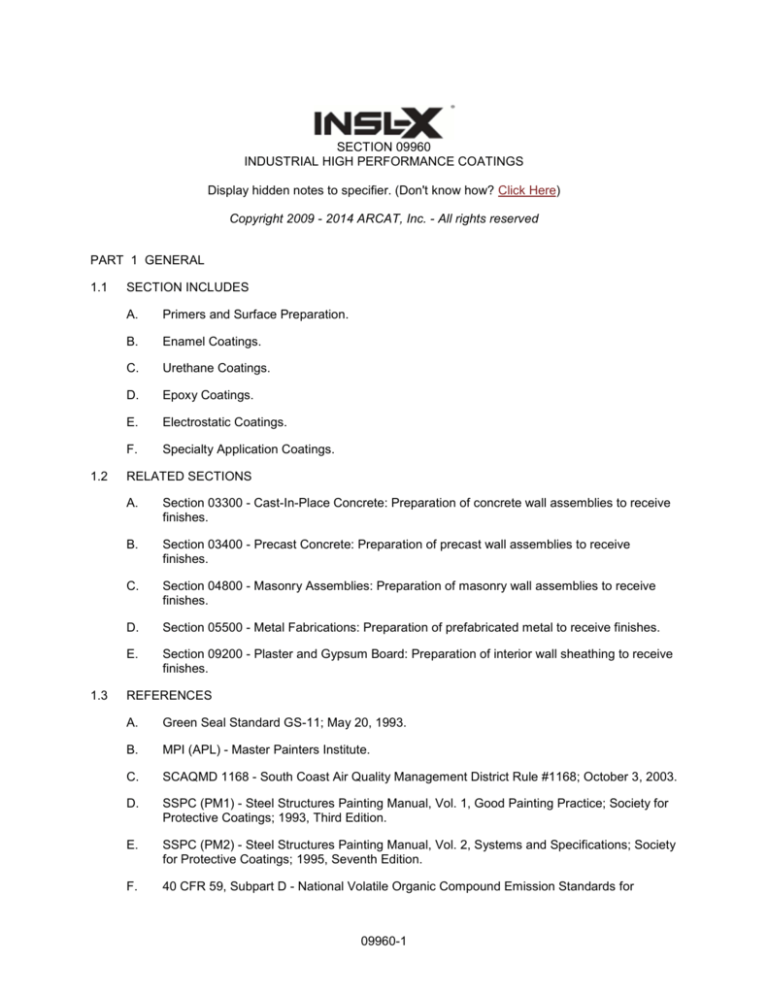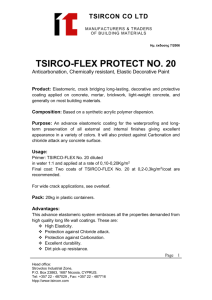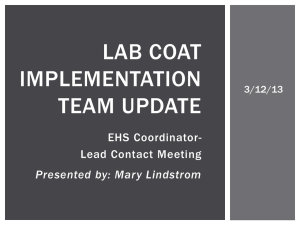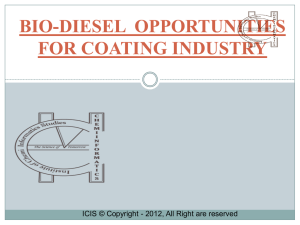
SECTION 09960
INDUSTRIAL HIGH PERFORMANCE COATINGS
Display hidden notes to specifier. (Don't know how? Click Here)
Copyright 2009 - 2014 ARCAT, Inc. - All rights reserved
PART 1 GENERAL
1.1
1.2
1.3
SECTION INCLUDES
A.
Primers and Surface Preparation.
B.
Enamel Coatings.
C.
Urethane Coatings.
D.
Epoxy Coatings.
E.
Electrostatic Coatings.
F.
Specialty Application Coatings.
RELATED SECTIONS
A.
Section 03300 - Cast-In-Place Concrete: Preparation of concrete wall assemblies to receive
finishes.
B.
Section 03400 - Precast Concrete: Preparation of precast wall assemblies to receive
finishes.
C.
Section 04800 - Masonry Assemblies: Preparation of masonry wall assemblies to receive
finishes.
D.
Section 05500 - Metal Fabrications: Preparation of prefabricated metal to receive finishes.
E.
Section 09200 - Plaster and Gypsum Board: Preparation of interior wall sheathing to receive
finishes.
REFERENCES
A.
Green Seal Standard GS-11; May 20, 1993.
B.
MPI (APL) - Master Painters Institute.
C.
SCAQMD 1168 - South Coast Air Quality Management District Rule #1168; October 3, 2003.
D.
SSPC (PM1) - Steel Structures Painting Manual, Vol. 1, Good Painting Practice; Society for
Protective Coatings; 1993, Third Edition.
E.
SSPC (PM2) - Steel Structures Painting Manual, Vol. 2, Systems and Specifications; Society
for Protective Coatings; 1995, Seventh Edition.
F.
40 CFR 59, Subpart D - National Volatile Organic Compound Emission Standards for
09960-1
Architectural Coatings; U.S. Environmental Protection Agency; current edition.
1.4
DEFINITIONS
A.
1.5
1.6
Paints are available in a wide range of sheens or glosses, as measured by a gloss meter
from a 60 degree angle from vertical, as a percentage of the amount of light that is reflected.
The following terms are used to describe the gloss of our products.
1.
Flat - Less than 5 Percent.
2.
Matte - 0 - 10 Percent.
3.
Eggshell - 10 - 25 Percent.
4.
Satin - 20 - 35 Percent.
5.
Semi-Gloss - 35 - 70 Percent.
6.
Gloss - 70 - 85 Percent.
SUBMITTALS
A.
Submit under provisions of Section 01300.
B.
Coordinate with Section 01305 - Submittals, for submittal procedures and LEED Submittal
Forms MRc3, MRc4, MRc5.
C.
LEED Certification Product Data:
1.
See Section 01115 - Green Building Requirements, for LEED certification submittal
forms and certification templates.
2.
Submittals Required:
a.
MRc3 Resource Reuse (LEED Form).
b.
MRc4 Recycled Content (LEED Form).
c.
MRc5 Local and Regional Materials (LEED Form).
d.
EQc4.1 Low Emitting Materials - Adhesives and Solvents (VOC Certification
Letter).
e.
EQc4.2 Low Emitting Materials - Paint (VOC Certification Letter).
f.
Green Seal Standard GS-11 Certified Product certificates.
D.
Product Data: Provide a complete list of all products to be used, with the following
information for each:
1.
Manufacturer's name, product name and/or catalog number, and general product
category.
2.
Cross-reference to specified paint system(s) that the product is to be used in; include
description of each system.
E.
Samples: Submit three paper samples, 5 inches by 7 inches (127mm x 178mm) in size,
illustrating selected colors for each color and system selected with specified coats cascaded.
F.
Manufacturer's Instructions: Indicate special surface preparation procedures.
G.
Maintenance Data: Submit data on cleaning, touch-up, and repair of painted and coated
surfaces.
QUALITY ASSURANCE
A.
Manufacturer Qualifications: All primary products specified in this section shall be supplied
by a single manufacturer with a minimum of ten (10) years experience.
B.
Installer Qualifications: All products listed in this section are to be installed by a single
installer with a minimum of five (5) years demonstrated experience in installing products of
the same type and scope as specified.
C.
Mock-Up: Provide a mock-up for evaluation of surface preparation techniques and
09960-2
application workmanship.
1.
Finish areas designated by Architect.
2.
Do not proceed with remaining work until workmanship, color, and sheen are
approved by Architect.
3.
Refinish mock-up area as required to produce acceptable work.
1.7
1.8
DELIVERY, STORAGE, AND HANDLING
A.
Store products in manufacturer's unopened packaging until ready for installation.
B.
Store and dispose of solvent-based materials, and materials used with solvent-based
materials, in accordance with requirements of local authorities having jurisdiction.
C.
Disposal:
1.
Never pour leftover coating down any sink or drain. Use up material on the job or seal
can and store safely for future use.
2.
Do not incinerate closed containers.
3.
For specific disposal or recycle guidelines, contact the local waste management
agency or district. Recycle whenever possible.
PROJECT CONDITIONS
A.
1.9
Maintain environmental conditions (temperature, humidity, and ventilation) within limits
recommended by manufacturer for optimum results. Do not install products under
environmental conditions outside manufacturer's absolute limits.
WARRANTY
A.
At project closeout, provide to the Owner or owner's representative an executed copy of the
Manufacturer's standard form outlining the terms and conditions of and any exclusions to
their Limited Warranty against Manufacturing Defect.
1.10 EXTRA MATERIALS
A.
At project closeout, supply the Owner or owner's representative one gallon of each product
for touch-up purposes.
B.
At project closeout, provide the color mixture name and code to the Owner or owner's
representative for accurate future color matching.
PART 2 PRODUCTS
2.1
2.2
MANUFACTURERS
A.
Acceptable Manufacturer: Insl-x, which is located at: 101 Paragon Dr.; Montvale, NJ 07645;
Toll Free Tel: 800-225-5554; Tel: 201-949-6000; Fax: 888-248-2143.;
Email:info@benjaminmoore.com; Web:www.insl-x.com
B.
Substitutions: Not permitted.
C.
Requests for substitutions will be considered in accordance with provisions of Section
01600.
LEED CRITERIA
A.
All paints and coatings used must meet the VOC limits of Green Seal Standard GS-11:
1.
Interior: 50 g/l VOC or less for Flats and 150 g/l VOC for Non Flats.
2.
Exterior: 100 g/l VOC for Flats and 200 g/l VOC or Less for Non Flats.
09960-3
B.
2.3
2.4
2.5
EQ CR4.2 Low Emitting Materials: 1 Credit - Paint.
MATERIALS - GENERAL
A.
Volatile Organic Compound (VOC) Content:
1.
Provide coatings that comply with the most stringent requirements specified in the
following:
a.
40 CFR 59, Subpart D--National Volatile Organic Compound Emission
Standards for Architectural Coatings.
b.
Determination of VOC Content: Testing and calculation in accordance with 40
CFR 59, Subpart D (EPA Method 24), exclusive of colorants added to a tint
base and water added at project site; or other method acceptable to authorities
having jurisdiction.
B.
Compatibility: Provide materials that are compatible with one another and the substrates
indicated under conditions of service and application, as demonstrated by manufacturer
based on testing and field experience.
MIXING AND TINTING
A.
Except where specifically noted in this section, all paint shall be ready-mixed and pre-tinted.
Agitate all paint prior to and during application to ensure uniform color, gloss, and
consistency.
B.
Thinner addition shall not exceed manufacturer's printed recommendations. Do not use
kerosene or other organic solvents to thin water-based paints.
C.
Where paint is to be sprayed, thin according to manufacturer's current guidelines.
CONCRETE SURFACES
A.
Primers and Corrosion Protection:
1.
Material: Corotech V110 Acrylic Metal Primer.
2.
Material: Corotech V155 100% Solid Epoxy Pre-Primer.
3.
Coats: One (1) Coat.
4.
Coats: Two (2) Coats.
B.
Enamel Coating:
1.
Material: Corotech V200/V201 Urethane Alkyd Enamel.
2.
Material: COROTECH V300 QUICK DRY ACRYLIC SPRAY DTM.
3.
Material: Corotech V230/V231 Quick Dry Alkyd Enamel or Corotech V225 High Solids
Rapid Dry Gloss Enamel.
4.
Material: Corotech V330/V331 Acrylic DTM Enamel.
5.
Material: Corotech V264 Silicone Alkyd High Heat Aluminum.
6.
Material: INSL-X FK-1310 FreezerKote.
7.
Coats: One (1) Coat.
8.
Coats: Two (2) Coats.
C.
Urethane Coating:
1.
Material: Corotech V500/V510 Acrylic Aliphatic Urethane Coating.
2.
Material: Corotech V540 Waterborne Aliphatic Urethane Coating.
3.
Material: Corotech V520 Polyester Urethane Coating.
4.
Coats: One (1) Coat.
5.
Coats: Two (2) Coats.
D.
Epoxy Coating:
1.
Material: Corotech V430 100% Solid Epoxy Floor Coating.
09960-4
2.
3.
4.
5.
6.
7.
8.
9.
10.
11.
12.
2.6
2.7
Material: Corotech V160 Epoxy Mastic Coating.
Material: Corotech V410 Fast Set Polymide Epoxy Coating.
Material: Corotech V400 Polymide Epoxy Coating.
Material: Corotech V440 Waterborne Amine Adduct Epoxy.
Material: Corotech V155 100% Solid Epoxy Pre-Primer.
Material: Corotech V150 Anti-Corrosive Epoxy Coating.
Material: Insl-x EGG-xxx Garage Guard Waterborne Epoxy Floor .
Coats: One (1) Coat.
Coats: Two (2) Coats.
Coats: One (1) Coat.
Coats: Two (2) Coats.
MASONRY SURFACES
A.
Primers and Corrosion Protection:
1.
Material: Corotech V110 Acrylic Metal Primer.
2.
Material: Corotech V155 100% Solid Epoxy Pre-Primer.
3.
Coats: One (1) Coat.
4.
Coats: Two (2) Coats.
B.
Enamel Coating:
1.
Material: Corotech V200/V201 Urethane Alkyd Enamel.
2.
Material: Corotech V300 Quick Dry Acrylic Spray DTM.
3.
Material: Corotech V230/V231 Quick Dry Alkyd Enamel or Corotech V225 High Solids
Rapid Dry Gloss Enamel.
4.
Material: Corotech V330/V331 Acrylic DTM Enamel.
5.
Material: Corotech V264 Silicone Alkyd High Heat Aluminum.
6.
Material: Inslx- FK 1310 FreezerKote.
7.
Coats: One (1) Coat.
8.
Coats: Two (2) Coats.
C.
Urethane Coating:
1.
Material: Corotech V500/V510 Acrylic Aliphatic Urethane Coating.
2.
Material: Corotech V540 Waterborne Aliphatic Urethane Coating.
3.
Material: Corotech V520 Polyester Urethane Coating.
4.
Coats: One (1) Coat.
5.
Coats: Two (2) Coats.
D.
Epoxy Coating:
1.
Material: Corotech V160 Epoxy Mastic Coating.
2.
Material: Corotech V410 Fast Set Polymide Epoxy Coating.
3.
Material: Corotech V400 Polymide Epoxy Coating.
4.
Material: Corotech V440 Waterborne Amine Adduct Epoxy.
5.
Material: Corotech V155 100% Solid Epoxy Pre-Primer.
6.
Coats: One (1) Coat.
7.
Coats: Two (2) Coats.
8.
Coats: One (1) Coat.
9.
Coats: Two (2) Coats.
METAL - FERROUS
A.
Primers and Corrosion Protection:
1.
Material: Corotech V131 Universal Metal Primer.
2.
Material: Corotech V133 Shop Cote Metal Primer.
3.
Material: Corotech V142 Shop Primer.
4.
Material: Corotech V110 Acrylic Metal Primer.
5.
Material: Corotech V155 100% Solid Epoxy Pre-Primer.
09960-5
6.
7.
8.
9.
2.8
Material: Corotech V150 Anti-Corrosive Epoxy Primer.
Material: Corotech V170 Organic Zinc Rich Primer.
Coats: One (1) Coat.
Coats: Two (2) Coats.
B.
Enamel Coating:
1.
Material: Corotech V200/V201 Urethane Alkyd Enamel.
2.
Material: Corotech V300 Quick Dry Acrylic Spray DTM.
3.
Material: Corotech V230/V231 Quick Dry Alkyd Enamel.
4.
Material: Corotech V264 Silicone Alkyd High Heat Aluminum.
5.
Coats: One (1) Coat.
6.
Coats: Two (2) Coats.
C.
Urethane Coating:
1.
Material: Corotech V500/V510 Acrylic Aliphatic Urethane Coating.
2.
Material: Corotech V540 Waterborne Aliphatic Urethane Coating.
3.
Material: Corotech V520 Polyester Urethane Coating.
4.
Coats: One (1) Coat.
5.
Coats: Two (2) Coats.
D.
Epoxy Coating:
1.
Material: Corotech V160 Epoxy Mastic Coating.
2.
Material: Corotech V410 Fast Set Polymide Epoxy Coating.
3.
Material: Corotech V400 Polymide Epoxy Coating.
4.
Material: Corotech V440 Waterborne Amine Adduct Epoxy.
5.
Material: Corotech V155 100% Solid Epoxy Pre-Primer.
6.
Material: Corotech V150 Anti-Corrosive Epoxy Coating.
7.
Coats: One (1) Coat.
8.
Coats: Two (2) Coats.
9.
Coats: One (1) Coat.
10.
Coats: Two (2) Coats.
E.
Direct to Metal (DTM) Coating:
1.
Material: Corotech V175 Waterborne Bonding Primer.
2.
Material: Corotech V330/V331 Acrylic DTM Enamel.
3.
Material: Corotech V230/V231 Quick Dry Alkyd Enamel or Corotech V225 High Solids
Rapid Dry Gloss Enamel.
4.
Material: Insl-x FK 1310 Freezer Kote.
5.
Coats: One (1) Coat.
6.
Coats: Two (2) Coats.
F.
Electrostatic Coating:
1.
Material: Corotech V260 Electrostatic Alkyd Enamel.
2.
Coats: One (1) Coat.
3.
Coats: Two (2) Coats.
METAL - NON-FERROUS
A.
Primers and Corrosion Protection:
1.
Material: Corotech V131 Universal Metal Primer.
2.
Material: Corotech V142 Shop Primer.
3.
Material: Corotech V110 Acrylic Metal Primer.
4.
Material: Corotech V155 100% Solid Epoxy Pre-Primer.
5.
Material: Corotech V150 Anti-Corrosive Epoxy Primer.
6.
Material: Corotech V170 Organic Zinc Rich Primer.
7.
Coats: One (1) Coat.
8.
Coats: Two (2) Coats.
09960-6
2.9
B.
Enamel Coating:
1.
Material: Corotech V200/V201 Urethane Alkyd Enamel.
2.
Material: Corotech V300 Quick Dry Acrylic Spray DTM.
3.
Material: Corotech V230/V231 Quick Dry Alkyd Enamel or Corotech V225 High Solids
Rapid Dry Gloss Enamel.
4.
Material: Corotech V264 Silicone Alkyd High Heat Aluminum.
5.
Coats: One (1) Coat.
6.
Coats: Two (2) Coats.
C.
Urethane Coating:
1.
Material: Corotech V500/V510 Acrylic Aliphatic Urethane Coating.
2.
Material: Corotech V540 Waterborne Aliphatic Urethane Coating.
3.
Material: Corotech V520 Polyester Urethane Coating.
4.
Coats: One (1) Coat.
5.
Coats: Two (2) Coats.
D.
Epoxy Coating:
1.
Material: Corotech V160 Epoxy Mastic Coating.
2.
Material: Corotech V410 Fast Set Polymide Epoxy Coating.
3.
Material: Corotech V400 Polymide Epoxy Coating.
4.
Material: Corotech V440 Waterborne Amine Adduct Epoxy.
5.
Material: Corotech V150 Anti-Corrosive Epoxy Coating.
6.
Coats: One (1) Coat.
7.
Coats: Two (2) Coats.
E.
Direct to Metal (DTM) Coating:
1.
Material: Corotech V175 Waterborne Bonding Primer.
2.
Material: Corotech V330/V331 Acrylic DTM Enamel.
3.
Material: Corotech V230/V231 Quick Dry Alkyd Enamel or Corotech V225 High Solids
Rapid Dry Gloss Enamel.
4.
Material: Insl-x FK 1310 FreezerKote.
5.
Coats: One (1) Coat.
6.
Coats: Two (2) Coats.
F.
Electrostatic Coating:
1.
Material: Corotech V260 Electrostatic Alkyd Enamel.
2.
Coats: One (1) Coat.
3.
Coats: Two (2) Coats.
METAL - GALVANIZED
A.
Primers and Corrosion Protection:
1.
Material: Corotech V131 Universal Metal Primer.
2.
Material: Corotech V142 Shop Primer.
3.
Material: Corotech V110 Acrylic Metal Primer.
4.
Material: Corotech V155 100% Solid Epoxy Pre-Primer.
5.
Material: Corotech V150 Anti-Corrosive Epoxy Primer.
6.
Material: Corotech V170 Organic Zinc Rich Primer.
7.
Coats: One (1) Coat.
8.
Coats: Two (2) Coats.
B.
Enamel Coating:
1.
Material: Corotech V200/V201 Urethane Alkyd Enamel.
2.
Material: Corotech V300 Quick Dry Acrylic Spray DTM.
3.
Material: Corotech V230/V231 Quick Dry Alkyd Enamel.
4.
Material: Corotech V264 Silicone Alkyd High Heat Aluminum.
5.
Coats: One (1) Coat.
09960-7
6.
Coats: Two (2) Coats.
C.
Urethane Coating:
1.
Material: Corotech V500/V510 Acrylic Aliphatic Urethane Coating.
2.
Material: Corotech V540 Waterborne Aliphatic Urethane Coating.
3.
Material: Corotech V520 Polyester Urethane Coating.
4.
Coats: One (1) Coat.
5.
Coats: Two (2) Coats.
D.
Epoxy Coating:
1.
Material: Corotech V160 Epoxy Mastic Coating.
2.
Material: Corotech V410 Fast Set Polymide Epoxy Coating.
3.
Material: Corotech V400 Polymide Epoxy Coating.
4.
Material: Corotech V440 Waterborne Amine Adduct Epoxy.
5.
Material: Corotech V155 100% Solid Epoxy Pre-Primer.
6.
Material: Corotech V150 Anti-Corrosive Epoxy Coating.
7.
Coats: One (1) Coat.
8.
Coats: Two (2) Coats.
E.
Direct to Metal (DTM) Coating:
1.
Material: Corotech V175 Waterborne Bonding Primer.
2.
Material: Corotech V330/V331 Acrylic DTM Enamel.
3.
Material: Corotech V230/V231 Quick Dry Alkyd Enamel or Corotech V225 High Solids
Rapid Dry Gloss Enamel.
4.
Coats: One (1) Coat.
5.
Coats: Two (2) Coats.
2.10 FIBERGLASS AND PLASTIC
A.
Primers and Corrosion Protection:
1.
Material: Corotech V110 Acrylic Metal Primer.
2.
Coats: One (1) Coat.
3.
Coats: Two (2) Coats.
B.
Enamel Coating:
1.
Material: Corotech V330/V331 Acrylic DTM Enamel.
2.
Coats: One (1) Coat.
3.
Coats: Two (2) Coats.
C.
Urethane Coating:
1.
Material: Corotech V520 Polyester Urethane Coating.
2.
Coats: One (1) Coat.
3.
Coats: Two (2) Coats.
D.
Epoxy Coating:
1.
Material: Corotech V160 Epoxy Mastic Coating.
2.
Material: Corotech V410 Fast Set Polymide Epoxy Coating.
3.
Material: Corotech V400 Polymide Epoxy Coating.
4.
Material: Corotech V440 Waterborne Amine Adduct Epoxy.
5.
Coats: One (1) Coat.
6.
Coats: Two (2) Coats.
7.
Coats: One (1) Coat.
8.
Coats: Two (2) Coats.
2.11 WOOD
A.
Primers:
09960-8
1.
2.
3.
Material: AQ0400 Aqua Lock Plus.
Coats: One (1) Coat.
Coats: Two (2) Coats.
B.
Enamel Coating:
1.
Material: Corotech V300 Quick Dry Acrylic Spray DTM.
2.
Material: Corotech V230/V231 Quick Dry Alkyd Enamel or Corotech V225 High Solids
Rapid Dry Gloss Enamel.
3.
Material: Corotech V330/V331 Acrylic DTM Enamel.
4.
Material: Corotech V264 Silicone Alkyd High Heat Aluminum.
5.
Material: Insl-s FK 1310 FreezerKote.
6.
Coats: One (1) Coat.
7.
Coats: Two (2) Coats.
C.
Epoxy Coating:
1.
Material: Corotech V160 Epoxy Mastic Coating.
2.
Material: Corotech V410 Fast Set Polymide Epoxy Coating.
3.
Material: Corotech V400 Polymide Epoxy Coating.
4.
Material: Corotech V440 Waterborne Amine Adduct Epoxy.
5.
Material: Corotech V155 100% Solid Epoxy Pre-Primer.
6.
Coats: One (1) Coat.
7.
Coats: Two (2) Coats.
2.12 GLASS, GLAZED TILE, FORMICA AND GLOSS COATINGS
A.
Primers and Corrosion Protection:
1.
Material: Corotech V110 Acrylic Metal Primer.
2.
Coats: One (1) Coat.
3.
Coats: Two (2) Coats.
B.
Enamel Coating:
1.
Material: Corotech V330/V331 Acrylic DTM Enamel.
2.
Coats: One (1) Coat.
3.
Coats: Two (2) Coats.
C.
Epoxy Coating:
1.
Material: Corotech V160 Epoxy Mastic Coating.
2.
Material: Corotech V410 Fast Set Polymide Epoxy Coating.
3.
Material: Corotech V400 Polymide Epoxy Coating.
4.
Material: Corotech V440 Waterborne Amine Adduct Epoxy.
5.
Coats: One (1) Coat.
6.
Coats: Two (2) Coats.
7.
Coats: One (1) Coat.
8.
Coats: Two (2) Coats.
2.13 AGED COATINGS
A.
Primers and Corrosion Protection:
1.
Material: Corotech V110 Acrylic Metal Primer.
2.
Coats: One (1) Coat.
3.
Coats: Two (2) Coats.
B.
Enamel Coating:
1.
Material: Corotech V300 Quick Dry Acrylic Spray DTM.
2.
Material: Corotech V230/V231 Quick Dry Alkyd Enamel or Corotech V225 High Solids
Rapid Dry Gloss Enamel.
3.
Material: Corotech V330/V331 Acrylic DTM Enamel.
09960-9
4.
5.
6.
Material: Insl-x FK 1310 FreezerKote.
Coats: One (1) Coat.
Coats: Two (2) Coats.
C.
Urethane Coating:
1.
Material: Corotech V500/V510 Acrylic Aliphatic Urethane Coating.
2.
Coats: One (1) Coat.
3.
Coats: Two (2) Coats.
D.
Epoxy Coating:
1.
Material: Corotech V160 Epoxy Mastic Coating.
2.
Material: Corotech V410 Fast Set Polymide Epoxy Coating.
3.
Material: Corotech V400 Polymide Epoxy Coating.
4.
Material: Corotech V440 Waterborne Amine Adduct Epoxy.
5.
Coats: One (1) Coat.
6.
Coats: Two (2) Coats.
7.
Coats: One (1) Coat.
8.
Coats: Two (2) Coats.
2.14 SPECIALTY APPLICATIONS
A.
Asphalt and Concrete Zone Marking:
1.
Material: TP24XX Alkyd Paint.
2.
Material: TP2200 Latex Traffic Paint.
3.
Coats: One (1) Coat.
4.
Coats: Two (2) Coats.
B.
High Temperature Coating:
1.
Material: Corotech V264 Silicone Alkyd High Heat Aluminum.
2.
Coats: One (1) Coat.
3.
Coats: Two (2) Coats.
PART 3 EXECUTION
3.1
EXAMINATION
A.
Do not begin installation until substrates have been properly prepared.
B.
Ensure that surfaces to receive paint are dry immediately prior to application.
C.
Ensure that moisture-retaining substrates to receive paint have moisture content within
tolerances allowed by coating manufacturer. Where exceeding the following values, promptly
notify Architect and obtain direction before beginning work.
1.
Concrete and Masonry: 13 percent. Allow new concrete to cure a minimum of 28
days.
2.
Exterior Wood: 17 percent.
3.
Interior Wood: 15 percent.
4.
Interior Finish Detail Woodwork, Including Trim, and Casework: 10 percent.
5.
Concrete Slab-On-Grade: Perform calcium chloride test over 24 hour period or other
acceptable test to manufacturer. Verify acceptable moisture transmission and pH
levels.
D.
Examine surfaces to receive coatings for surface imperfections and contaminants that could
impair performance or appearance of coatings, including but not limited to, loose primer,
rust, scale, oil, grease, mildew, algae, or fungus, stains or marks, cracks, indentations, or
abrasions.
09960-10
E.
3.2
3.3
Correct conditions that could impair performance or appearance of coatings in accordance
with specified surface preparation procedures before proceeding with coating application.
PREPARATION - GENERAL
A.
Clean surfaces thoroughly prior to coating application.
B.
Do not start work until surfaces to be finished are in proper condition to produce finished
surfaces of uniform, satisfactory appearance.
C.
Stains and Marks: Remove completely, if possible, using materials and methods
recommended by coating manufacturer; cover stains and marks which cannot be completely
removed with isolating primer or sealer recommended by coating manufacturer to prevent
bleed-through.
D.
Remove Mildew, Algae, and Fungus using materials and methods recommended by coating
manufacturer.
E.
Remove dust and loose particulate matter from surfaces to receive coatings immediately
prior to coating application.
F.
Remove or protect adjacent hardware, electrical equipment plates, mechanical grilles and
louvers, lighting fixture trim, and other items not indicated to receive coatings.
G.
Move or protect equipment and fixtures adjacent to surfaces indicated to receive coatings to
allow application of coatings.
H.
Protect adjacent surfaces not indicated to receive coatings.
I.
Prepare surfaces in accordance with manufacturer's instructions for specified coatings and
indicated materials, using only methods and materials recommended by coating
manufacturer.
SURFACE PREPARATION
A.
Concrete and Concrete Masonry: Clean surfaces free of loose particles, sand, efflorescence,
laitance, form oil, curing compounds, and other substances which could impair coating
performance or appearance.
B.
Concrete Floors: Remove contaminants which could impair coating performance or
appearance. Verify moisture transmission and alkaline-acid balance recommended by
coating manufacturer; mechanically abrade surface to achieve 80-100 grit mediumsandpaper texture.
C.
Existing Coatings:
1.
Remove surface irregularities by scraping or sanding to produce uniform substrate for
coating application; apply one coat primer of type recommended by coating
manufacturer for maximum coating adhesion.
2.
If presence of lead in existing coatings is suspected, cease surface preparation and
notify Architect immediately.
D.
Masonry Surfaces - Restored: Remove loose particles, sand, efflorescence, laitance,
cleaning compounds and other substances that could impair coating performance or
appearance.
E.
Metals - Aluminum, Mill-Finish: Clean and etch surfaces with a phosphoric acid-water
solution or water based industrial cleaner. Flush with clean water and allow to dry, before
applying primer coat.
09960-11
3.4
F.
Metals - Copper: Clean surfaces with pressurized steam, pressurized water, or solvent
washing.
G.
Metals - Ferrous, Unprimed: Remove rust or scale, if present, by wire brush cleaning, power
tool cleaning, or sandblast cleaning; remove grease, oil, and other contaminants which could
impair coating performance or appearance by solvent cleaning, with phosphoric-acid solution
cleaning of welds, bolts and nuts; spot-prime repaired welds with specified primer.
H.
Metals - Ferrous, Shop-Primed: Remove loose primer and rust, if present, by scraping and
sanding, feathering edges of cleaned areas to produce uniform flat surface; solvent-clean
surfaces and spot-prime bare metal with specified primer, feathering edges to produce
uniform flat surface.
I.
Metals - Galvanized Steel (not passivated): Clean with a water-based industrial strength
cleaner, apply an adhesion promoter followed by a clean water rinse. Alternately, wipe down
surfaces using clean, lint-free cloths saturated with xylene or lacquer thinner; followed by
wiping the surface dry using clean, lint-free cloths.
J.
Metals - Galvanized Steel, Passivated: Clean with water-based industrial strength cleaner.
After the surface has been prepared, apply recommended primer to a small area. Allow
primer to cure for 7 days, and test adhesion using the "cross-hatch adhesion tape test"
method in accordance with ASTM D 3359. If the adhesion of the primer is positive, proceed
with a recommended coating system for galvanized metal.
K.
Metals - Stainless Steel: Clean surfaces with pressurized steam, pressurized water, or
water-based industrial cleaner.
L.
Wood:
1.
Seal knots, pitch streaks, and sap areas with sealer recommended by coating
manufacturer; fill nail recesses and cracks with filler recommended by coating
manufacturer; sand surfaces smooth.
2.
Apply primer coat to back of wood trim and paneling.
APPLICATION - GENERAL
A.
Apply each coat to uniform coating thickness in accordance with manufacturer's instructions,
not exceeding manufacturer's specified maximum spread rate for indicated surface; thins,
brush marks, roller marks, orange-peel, or other application imperfections are not permitted.
B.
Allow manufacturer's specified drying time, and ensure correct coating adhesion, for each
coat before applying next coat.
C.
Inspect each coat before applying next coat; touch-up surface imperfections with coating
material, feathering, and sanding if required; touch-up areas to achieve flat, uniform surface
without surface defects visible from 5 feet (1.5 m).
D.
Remove dust and other foreign materials from substrate immediately prior to applying each
coat.
E.
Where application abuts other materials or other coating color, terminate coating with a
clean sharp termination line without coating overlap.
F.
Where color changes occur between adjoining spaces, through framed openings that are of
same color as adjoining surfaces, change color at outside stop corner nearest to face of
closed door.
G.
Re-prepare and re-coat unsatisfactory finishes; refinish entire area to corners or other
natural terminations.
09960-12
3.5
3.6
CLEANING
A.
Clean excess coating materials, and coating materials deposited on surfaces not indicated to
receive coatings, as construction activities of this section progress; do not allow to dry.
B.
Re-install hardware, electrical equipment plates, mechanical grilles and louvers, lighting
fixture trim, and other items that have been removed to protect from contact with coatings.
C.
Reconnect equipment adjacent to surfaces indicated to receive coatings.
D.
Relocate to original position equipment and fixtures that have been moved to allow
application of coatings.
E.
Remove protective materials.
PROTECTION
A.
Protect completed coating applications from damage by subsequent construction activities.
B.
Repair to Architect's acceptance coatings damaged by subsequent construction activities.
Where repairs cannot be made to Architect's acceptance, re-apply finish coating to nearest
adjacent change of surface plane, in both horizontal and vertical directions.
END OF SECTION
09960-13







